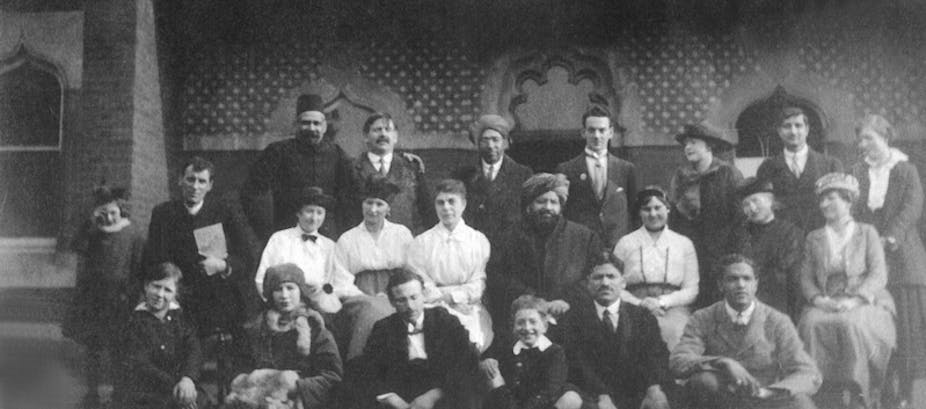The two first British mosques were established in 1889 in Liverpool and Woking, and women played a major contribution to the communities that helped to set up these mosques. But you wouldn’t necessarily know it. Indeed, women’s contributions throughout history are consistently forgotten – often lost so the past becomes “his story”. I hope my new research will play a part in changing this.
I used archive material linked to the two earliest British mosques to examine the everyday lives of women in these historical communities. This research presents a coherent and compelling narrative of women’s lives and roles as contributors and leaders of their communities.
Women in these communities were usually middle-class converts, who encountered Islam through travel, mosque publications or public lectures. They lived in an environment that viewed Islam and Muslims with suspicion and ridicule. British Muslims were perceived as “loyal enemies” and “infidels within” the society of that time.

At both the Liverpool and Woking mosques, women were included in Eid celebrations, debates and other events. The women at the Liverpool mosque also ran a home for the city’s “destitute” children, which was established in January 1897.
Women wrote for mosque publications, which also celebrated women’s achievements. In January 1895, the Liverpool Mosque newsletter noted that Mrs Zubeida Ali Akbar had the honour of being presented to the Queen. On March 20 1895, it noted that Miss Teyba Bilgrami, “a young Mahommedan lady of Hyderabad”, had passed the first exam in the arts at Madras University.
Refreshments and entertainment
Women were nearly always in charge of refreshments and “entertainment” at mosque events, including an annual Christmas breakfast that the Liverpool Muslim Institute organised. Women were initially excluded from the literary and debating society – this being only for “young men”. Then in March 1896, for the first time a woman, Rosa Warren, gave a talk on the poet Henry Wadsworth Longfellow .

Articles in mosque publications, usually written by men, show how Muslim patriarchy of the time converged with that of Victorian society to marginalise women. For example, poetry published in the Liverpool Mosque newsletter derides “the New Woman” who:
had studied mathematics … knew all about mythology … her mind was drilled in science … knew all the dates of history … Could talk with great loquacity on questions of capacity, but couldn’t sew a button on her little brother’s pants.
Trailblazing women
Yet there were also women who challenged these patriarchies. As part of my research, I uncovered many interesting stories of women and their roles in the mosques. There was Mrs Nafeesa T Keep, for example, a convert to Islam who arrived in Liverpool from the United States. She gave talks on Islam and women’s rights, challenging both patriarchal understandings of Islam and stereotypes of Islam. She was appointed the assistant superintendent of the Medressah-i-iyyum-al-Sebbah, an institution aimed at educating young Muslims on religion.

There was also Madame Teresa Griffin Viele (1831–1906), who took the Muslim name Sadika Hanoum. She was a news correspondent for the Liverpool Mosque, writing the “Resume of Political Events” in its journal from September 1894 to April 1895. And Lady Evelyn Zainab Cobbold, a high-profile convert from an aristocratic British family, who became one of the first European women to perform the Hajj or pilgrimage to Mecca. Extraordinarily for her time, she performed the pilgrimage on her own, in a motor car and then wrote a best-selling book in 1934 about her experiences.
Other women in this community include Fatima Cates, who was a key member and indeed founding treasurer of the Liverpool Muslim Institute, the body that itself founded Britain’s first mosque in the city. Meanwhile, another woman, Begum Shah Jahan of Bhopal, India, funded Britain’s first purpose-built mosque in Woking. Women were therefore central to the foundation of the first mosques in Britain.

Rewriting history
Indeed, as my research shows, history puts women at the centre of the establishment of Islam in Britain. And in their own different ways, these women took on roles of leadership and representation. They lived at a time that was socially and culturally extremely different from that of contemporary British Muslims. Yet the issues these women encountered in their practice of Islam, their negotiations with multiple patriarchies, and their daily lives are not unlike the issues around gender and mosque leadership debated in contemporary Britain.
By shining a light on the history of Muslim women in Britain, contemporary issues seem less insurmountable. These women shaped the Muslim communities of their time and it is imperative that their stories are known.


